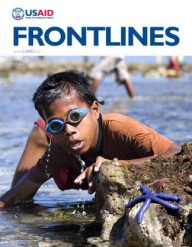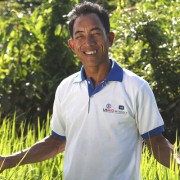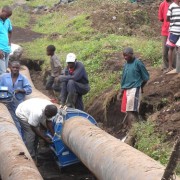The Congo River Basin, located in central Africa, contains 3.7 million square kilometers of contiguous tropical forest, second in size only to the Amazon.
The basin’s forests harbor endemic, threatened and globally important biodiversity. These forests are also a source of food, medicine, materials, fuel and shelter for over 80 million people. Equally importantly, the basin’s forests serve as an important global “sink” for carbon dioxide, the most important gas implicated in global warming.
The Democratic Republic of Congo (DRC), which is in the heart of central Africa, alone has 145 million hectares of forests, representing over 50 percent of the continent’s tropical forests and a stock of over 140 gigatons of carbon, or over three years of global emissions.
The country is one of the world’s richest areas for fauna, with 1,200 species of birds and over 400 species of mammals. Of these, 16 species of birds and 23 species of mammals are considered threatened or endangered. The Congo Basin region also supports the world's largest populations of gorillas, chimpanzees, bonobos and forest elephants.
Economic growth and poverty alleviation are dependent on the sustainable use and sound management of natural resources in the Central African forests. Although the rate of forest loss in the Congo Basin—0.23 percent between 2000 and 2010—is relatively low compared to other regions such as the Amazon, it represents the loss of several million hectares per year. The major causes of deforestation include shifting cultivation (slash and burn), forest exploitation for timber and charcoal, and infrastructure development, including agriculture, mining and energy. If these forests are not rationally managed, their ability to conserve globally important biodiversity and help regulate the global climate will be sharply degraded.
Monitoring the vast rainforest that covers about one-third of the Congo Basin is however, an immense challenge, particularly due to the almost complete lack of roads. Nevertheless, over the past decade, new technologies, including remote sensing and Geographic Information Systems (GIS), have emerged as powerful tools in forest monitoring that can provide critical information to decision makers on how to protect this valued natural resource.
Remote sensing includes taking images of Earth from satellites over an area ranging from a few square kilometers to the entire globe. GIS integrates hardware, software and data for capturing, managing, analyzing and displaying all forms of geographically referenced information. GIS has enabled researchers to monitor remote areas not accessible in the past. In central Africa, data was previously collected through global studies conducted on large scale areas by international NGOs.
Beginning in 2000, USAID helped bring these new technologies to the Congo Basin and train men and women who live in this region to deploy them. When environment ministers from around Central Africa created a new watchdog for the Congo Basin forests called OSFAC (Observatoire Satellital des Forets d’Afrique Centrale in French, or Central African Forest Satellite Observatory), the Agency’s Central Africa Regional Program for Environment (CARPE) helped OSFAC get off the ground.
OSFAC’s primary objective is to support the improved management of natural resources and sustainable development by producing reliable forest cover change information and building the capacity of public and private conservation partners to use the latest satellite-based tools and information.
Originally focused on DRC, Kinshasa-based OSFAC became a regional NGO in 2005. Over the years, the watchdog's technical capacity has expanded and it has formed new partnerships. It has GIS and remote sensing labs at both its headquarters and the School of Agronomy at the University of Kinshasa.
“For many years, the Congo Basin was behind in using scientific data from satellites to monitor the environment, especially the forest cover change. But now we have built local capacity that can manipulate information from NASA and other cutting-edge sources and publish information products in leading environmental journals,” said Landing Mané, OSFAC director.
For the past few years, USAID has supported academic and research institutions, including the University of Maryland and the South Dakota State University, to provide technical and capacity support to OSFAC to produce the first publication on forest cover and loss in Central Africa countries from 2000 to 2010.
The publication serves as a useful addition to many projects, including monitoring of biodiversity, climate modeling, natural resource management and soil use planning. These atlases were developed as part of the OSFAC initiative “Monitoring the forests of Central Africa using remotely sensed data sets” (FACET in French).
“FACET is a useful tool for conservation workers to better understand and develop suitable and sustainable programming to address deforestation and forest degradation in the long term,” said Karl Wurster, natural resources officer for CARPE. “This is critical because the Central African forests are a key source of carbon stocks, which make an important contribution to global climate change mitigation.”
FACET also has the potential to emerge as the key reference document for Central African countries as they develop national baselines to implement monitoring, reporting and verification of carbon emissions for their national REDD + (Reducing Emissions from Deforestation and Forest Degradation) programs.
From 2005 until 2013, OSFAC trained over 1,500 people in the region in GIS and remote sensing applications, and is currently expanding capacity building in other Central African countries, including the Republic of Congo and Central African Republic.
“In the DRC, more than 80 percent of people working in the field of GIS and remote sensing have been trained by OSFAC. Most of them are currently working in national institutions, international NGOs, U.N. bodies, universities and projects,” said Eric Lutete, OSFAC’s GIS lab manager.
Trainees are university students, staff from national ministries, NGO personnel and independent professionals. Bob Boseko Bokanga is one of the many Congolese students who received training on GIS at the School of Agronomy at the University of Kinshasa where OSFAC has its second GIS Lab.
“I am grateful because all I know to do my work, I learned at OSFAC,” said Boseko. “Students at the School of Agronomy, and recently from the Higher Institute of Medical Techniques in Kinshasa, are trained as part of their GIS-related course assignments.”
Since 1995, over 50,000 men and women have been trained in a variety of areas such as remote sensing, spatial planning and climate change monitoring throughout Central Africa as a result of USAID support.
Martin McLaughlin, former acting director of CARPE, underscores the significance of OSFAC’s activities: “Monitoring Central Africa’s forests is of critical interest for the global community. Ultimately, sustainable management of the Congo Basin forests requires building African-led scientific, analytic and policy-making capacity. OSFAC is 100 percent African-staffed, and it is the leader in providing forest cover information to Central African governments and civil society.”











Comment
Make a general inquiry or suggest an improvement.